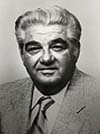1999Longtime labor leader ‘Blackie’ Evans to retire
Claude "Blackie" Evans, who hitchhiked to Henderson at age 17, fibbed about his age to get his first union job and became a major voice of organized labor in Nevada for nearly half a century, said Wednesday that he is retiring.
Evans, 63, said he will submit on March 8 his letter of resignation as secretary-treasurer of the state AFL-CIO, a post he has held for seven terms. AFL-CIO board members have been informed that the resignation will be effective Aug. 30, to coincide with the 21st anniversary of Evans' first election to state labor chief.
"I made the decision over the holidays," Evans said. "I was not feeling well and I just felt it was time to retire."
Before his tenure with the AFL-CIO, Evans worked seven years as state labor commissioner and 18 years at Titanium Metals in Henderson."
Evans was diagnosed two years ago with adult onset diabetes. Over the holidays, he says he overindulged in the wrong type of foods, resulting in his blood-sugar level rising to dangerous levels.
"It has been a hell of a ride and I have no regrets about the things I did to help the workers, who were always my first concern," he said. "I never hesitated to open my mouth and be blunt. I was too darn dumb to lie and I was clean as a hound's tooth."
Culinary Union Local 226 Secretary-Treasurer Jim Arnold, a longtime friend, said this is not a happy day for organized labor, but Evans has more than earned his retirement.
"It is always sad to see someone retire from any job, but Blackie gave a lot of dedicated years to organized labor," said Arnold, whose late father, local labor leader Jim Arnold Sr., also was a close friend of Evans.
"Blackie's dedication was to all working people. He fought for fair wages and benefits for all workers, organized or not."
The AFL-CIO board will select a member to finish the last month of Evans' term, which expires Oct. 1. Evans will recommend Danny Thompson, the state AFL-CIO political action director and the man Evans has for the last five years groomed to take his place.
An election will be held in the fall for the 145,000 state union workers from 79 labor organizations -- the largest of which is the 40,000-member Culinary Union -- to pick the new secretary-treasurer. Given the history of the post, that individual could serve a long time. Before Evans won in 1978, Lou Paley held the post unopposed for 25 years.
"I don't think there will be a problem (with the transition) because Blackie has built such a solid foundation that his successor will hit the ground running," said U.S. Sen. Harry Reid, D-Nev., who met Evans in 1964 when Reid was Henderson city attorney.
"Blackie was not college educated. He got his education on the streets and in the factories, and has been an intelligent leader," Reid said.
Former Nevada Gov. Mike O'Callaghan, now executive editor of the Sun, first met Evans as a steel worker in Henderson and in 1971 appointed him state labor commissioner in charge of the workers compensation system.
"He never forgot the working people and their families," O'Callaghan said. "He would drive 100 miles or more and deliver a check to a widow of a worker who died on the job."
Born Nov. 26, 1935, in Galena, Kan., Evans -- who got his colorful nickname from his dark complexion and wavy black hair, which has since turned white -- hitchhiked to Southern Nevada to join his uncle, who worked for the old Thunderbird hotel-casino.
At age 17, Evans got a job at Titanium Metals after claiming he was 18, the minimum age for workers. At first, he refused to pay the $3-a-month union dues, but reluctantly joined the union to help obtain a promotion.
A short time later, Evans was elected vice president of United Steelworkers of America Local 4856. He was promoted to president in 1961, when Local President Johnny Clements suffered a nervous breakdown during contract negotiations.
"There I was 26 and the whole thing was thrown in my lap," Evans said. "We settled in less than two weeks for what I thought was less than the workers deserved."
Four years later, while settling the 62-day 1965 strike at Titanium Metals, a more seasoned Evans accomplished what he calls his biggest victory in labor contract talks.
Evans secured the then-unheard of full cost-of-living increase, which laid the groundwork for the company paying what today is the highest wages in that industry. Also, the company pension plan was established at a dime-an-hour rate.
He is proud of the fact that 32 percent of workers in Las Vegas and 20 percent of workers in the state are organized. The national average is 14 to 16 percent. Also, all of the AFL-CIO-eligible unions in Nevada are AFL-CIO members.
And he believes Venetian owner Sheldon Adelson is "making a serious mistake" trying to keep the Culinary Union out of his yet-to-open Strip resort.
"He is an intelligent businessman who is making a bad business decision," Evans said. "Labor cannot afford to let him operate a hotel on the Strip without a union presence." He recalled the 5_frac1/2 years Culinary Union picketed outside the Frontier before that hotel signed a contract, and predicted the same will happen at the Venetian as well. "If he won't budge, it will be a war," he said.
Evans said has a few regrets at the end of his long career: "I never learned to speak Spanish, we endorsed a few bad candidates, and at times, I neglected my (four) children. That's one reason why I now spend a lot of time with my (four) grandchildren to make up for the time I was away from my kids, who all turned out OK thanks mainly to their mom."
Evans said he will remain a resident of Henderson and will live in the house where he and his wife of 46 years, Carolyn, have resided since 1977. He plans to do volunteer work and keep a hand in state labor, though not in a leadership capacity.
A retirement dinner honoring Evans is planned for Sept. 16 at a Strip resort. The details are in the works.
Las Vegas Sun, Thursday, Jan. 21, 1999
He died September 28, 1971
Evans was born Nov. 26, 1935, in Duenweg, Mo. He is survived by his wife, Carolyn Lorraine (Qualls) Evans, of 54 years; son, Steven, of Las Vegas; daughters, Cheree, of Reno, and Sienna and Lisa, both of Henderson; and four grandchildren.
{Ed. -- Blackie was born in Duenweg. He grew up in Galena where he lived all his life before departing to go west as a teenager.}
“Born Nov. 26, 1935, in Galena, Kan., Evans -- who got his colorful nickname from his dark complexion and wavy black hair, which has since turned white -- hitchhiked to Southern Nevada to join his uncle, who worked for the old Thunderbird hotel-casino.”
Las Vegas Sun, January 21, 1999
“As the state's most powerful union leader in the 1980s and '90s, Claude "Blackie" Evans had great discipline organizing work forces by the thousands and haggling with management for the best deal for the working man.”
Las Vegas Sun, October 3, 2007
 |
| Claudie "Blackie" Evans |




















